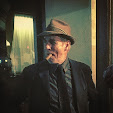 Jazz musicians do it.
Jazz musicians do it.When they want to access that place inside themselves where the improvisation flows unfettered.
When they want to stretch the boundaries, bend the rules, get their jam on.
When they want to fully immerse themselves in the sea of sound and happily drown in it.
When they want to catch the spacebus to the Wayoutisphere.
When they want to get out of their own way.
They close their eyes.
Why?
Charles J. Limb, M.D., assistant professor in the Department of Otolaryngology and a trained jazz saxophonist himself conceived of a way to put musicians engaged in this kind of spontaneous combustion into an MRI machine.
He wanted to see a brain on jazz.
They had to create instruments that
wouldn’t interfere with the powerful magnets of their functional magnetic resonance imaging apparatus.
The MRI.
While the musicians spontaneously improvised, they were able to monitor the brain activity.
They found the usual increase in activity in the medial prefrontal cortex, which sits in the center of the brain’s frontal lobe. This area has been linked with self-expression and individuality, such as telling a story about yourself.
It’s what lights up when we confess.
Brain On Jazz
But when they slimmed their findings to just those captured when the musicians were spontaneously improvising they found a pronounced decrease in the region of the brain known as the dorsolateral prefrontal cortex, a broad portion of the front of the brain that extends to the sides. This area has been linked to planned actions and self-censoring. This is the area known to govern our inhibitions.
Clowns' Dressing Room Door at the Jay Leno Show
When Jazz musicians close their eyes they may not be doing it to cut out the distraction of their sense of sight. It may just be the physical manifestation of their attempt to shut down the dorsolateral prefrontal cortex.
Play
Under the big top I do not have that option. My eyes must be open and alive to all the possibilities, scanning the audience, keeping connection to my fellow performers and alert to any comic ore that may be available to mine.
But I still need to foster that sense of spontaneity with every gesture, word and action.
How?
The amazing acrobats in our show train hard every day to keep their bodies in the condition necessary to perform their acts. They are like musicians playing their scales diligently in preparation for a difficult symphony.
The acrobats, for their safety, must adhere to a set routine. If something goes wrong, they have their hours of training to fall back on.
The acrobats are like classical musicians.
The clowns play jazz.
So even though I know our comic acts like a saxophone player knows the chord changes of a well-worn standard, I must infuse every moment with a percolating sense of spontaneity.
And like a good jazz musician, I’ll try to shut down the inhibitions and restraint that live in the dorsolateral prefrontal cortex, get out of my own way and just play.
Jazz Musician





1 comment:
I'm no where near the level of what you are doing but I've experienced a little bit of what you are talking about. I remember doing the scottish play (community theatre) and not remembering my lines. But then they came out of my mouth unbidden. That only happened once during the whole play. The rest of the time I was too busy trying.
With the difference between jazz musicians (clowns) and those who have a more rigid repetoir to follow, what if they are actually pretty similiar (but different.)
I wonder if having to do the same thing over and over, there is a freedom in that. You find the ease within the limits of what you are doing. And each time you do it, you can go deeper, finding a new connection. And so you are present but you are reacting (or responding) to what you feel your body doing. Meanwhile clown performers or jazz musicians are present in what is outside of themselves. The audience or higher consciousness.
Perhaps this is in agreement with what you are saying, that both types of performance require presence. And it is in the act of being present, whether limited or unlimited that joy arrises.
And perhaps when clowing or interacting with the audience what you are doing is sensing the "limits" of what is happening now so that you can respond. Meanwhile if a musician or acrobat is doing a set piece they are feeling where there body is within those limits-always slightly different-then they too can respond to what is happening now.
Post a Comment